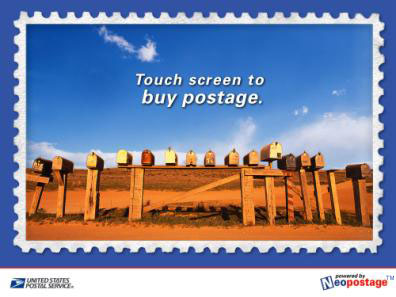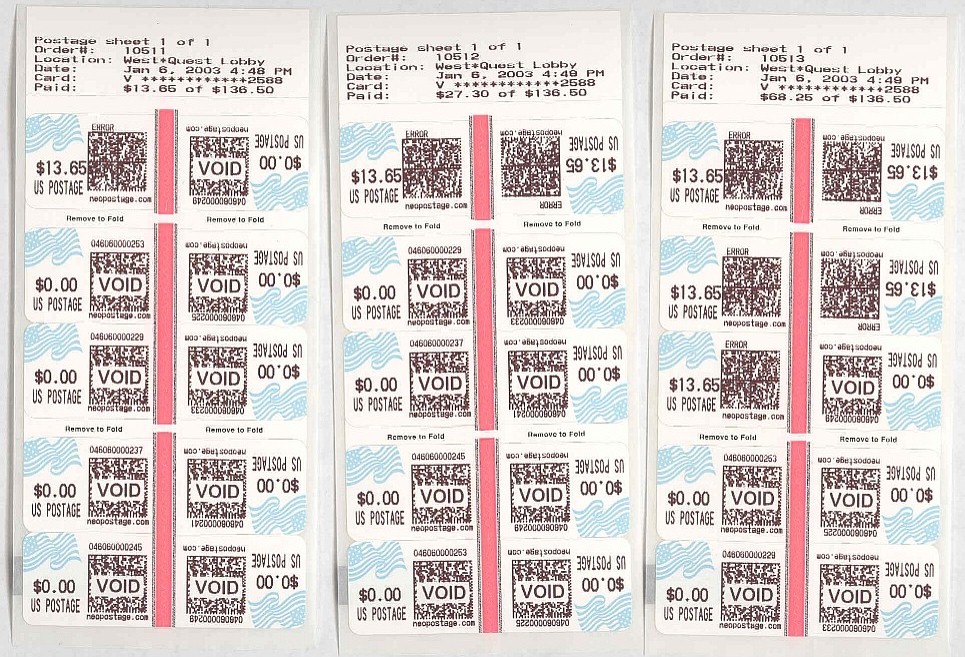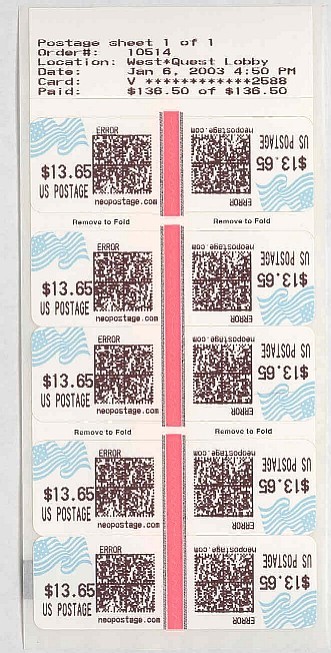
|
| This is a snapshot of the Kiosk's touch screen (with ten stamp update). |
Background Information
In June 2001, Neopost Online and Northrop Grumman Corporation introduced a self-service postage kiosk that is available 7 days a week, 24 hours a day. It is assumed that six kiosks were originally deployed (the city of Baltimore has a kiosk with the serial number 6). These kiosks were not initially made available to the general public. Employees of both companies were used to perform consumer testing.
The self-service kiosk dispenses postage and offers the same convenience of regular stamps. The kiosk has undergone engineering testing for proper operation of the hardware and software. Testing has also been performed on producing the highest quality stamp sheet. Initially, a sheet with four stamps was dispensed. The adhesive stamp stocked changed. As did the selvedge information and format on the sheets. The stamp design has also changed.
The United States Postage Service (USPS) gave approval on March 26, 2001 to perform kiosk testing (these are USPS approved stamps not prototype stamps). The kiosk was promoted as the " World's First Self-Service Kiosk for Online PC Postage". Neopost Online and Northrop Grumman Corporation was initially authorized to perform testing on the kiosk. The kiosk was originally identified as a "Simply Postage Kiosk" (it is currently identified as a "Neopostage Kiosk").
It is assumed that the kiosk are still undergoing USPS approval (documents originally indicate a 2002 nation-wide deployment). The kiosks are to be deployed in high traffic public locations.
Here is some information on how the stamp sheets are produced:
- The customer activates the kiosk by touching the screen.
- The customer selects the quantity of stamps.
- The customer is instructed to swipe a credit card.
- The kiosk logs on the centrally located database to get credit card authorization.
- The centrally located database provides approval and purchasing information back to the kiosk.
- The kiosk prints the purchasing and stamp information on continuous adhesive sheets dispensed from a roll.
- The adhesive sheets are guillotined from the roll and dispensed from the kiosk.
- The kiosks request if additional purchases are required. If no, the kiosk goes in a wait mode. If yes, the process restarts.
I have been fortunate in seeing maintenance being performed on the kiosk. I have seen the kiosk boot up and can identify what operating system is being used. I have also seen the roll of adhesive labels as is sits in the kiosk. I have also seen kiosk information printed on the adhesive labels (used to print kiosk status information, not stamps).
The proprietary secure self-adhesive labels have no monetary value, thus eliminating the need to tightly control and manage valuable preprinted stamp inventories. In addition, value can be assigned to the labels by simply printing the proper information on it. A visible security device that can be seen on the sheet is microprinting of the word Neopost (next to the fluorescent bar).
Its is rumored that when the current stock of labels are depleted, that a new colorized version will be used. This colorization will provide a red, white and blue flag.
Changes in the operation of the kiosk occurred prior to and after the June 30, 2002 postage rate change (as it relates to the Baltimore kiosk). The kiosk is running an updated version of the software. The software was design to be more user friendly (new Neopostage logos, Hispanic language option, and visually pleasing).
In addition to printing First Class postage (37c), new features of the kiosk include the ability to print additional ounce postage (23c and 60c), Priority ($3.85)and Express Mail postage ($13.65), and postcard (23c) and international postage (50c, 60c, 70c, and 80c). All of these denominations come in sheets of ten stamps. Purchasing quantities vary from 1 stamp to 50 stamps.
| Kiosk that dispenses the Neopostage stamps. |
|
|
Here is the official USPS bulletin anouncing the usage of the Neopost stamp (from the 4-count sheet) at "limited" number of sites. This bulletin is dated September 20, 2001.
| Display is touch activated (old screen shown ). |
|
|
4-count Sheet Purchase types (June 2001 - June 2002):
37c................4, 8, 12, 16, or 20-stamps
10-count Sheet Purchase types (June 2002 - Present):
37c................20, 30, 40, or 50-stamps
23c................10 or 20-stamps
60c................10 or 20-stamps
$3.85..............1, 2, 5, or 10-stamps
23c................20, 30, 40, or 50-stamps
50c...............10-stamps
60c...............10-stamps
70c...............10-stamps
80c...............10-stamps
$13.65............1, 2, 5, or 10-stamps
A "short set" consist of the items in red. A short set provides a collector's representation (i.e. for your stamp album) of all stamp denominations and/or stamps types. The 60c sheet is duplicated in the short set, however a short set is normally purchased in a fixed sequence (37c to $13.65), so that the 60c foreign purchase can be easily identified (between the 50c and 70c purchase).
Approximately 12 short sets were created in 2002 (July 2002 through December 2002) with the 10-count stamp sheets at kiosk #6.
An even rarer set is the "long set", all demoninations and its purchase types (you do the math - over $400). This is a large sum of money for a stamp purchase. Approximately 3 sets were made in 2002 at kiosk #6. A long set is difficult to make since each denomination purchase type may not have a selection on the screen (seems that Neopost runs different version of software with selections missing). For example, the 37c stamp has 4 purchase types (20, 30, 40, and 50). Normally the 30 and 40 purchase type are missing as a selection option on the screen.
Information Updates
February 1, 2003 Update.
The following picture is an amount paid error on the US Priority Mail stamp purchases. US Priority Mail stamps are available in quantities of 1, 2, 5, or 10. The first paid amount is for the current sheet purchase (in case an error occurs in dispensing multiple sheet of the purchase). The second paid amount is for the total amount of the current transaction (when dispensing multiple sheets of the purchase). The second paid amount is continually locked on $38.50.
January 17, 2003 Update.
Undocumented postal history. The Specialized Catalogue for Neopost Webenabled Stamps (specifically section 3.2) fails to mention the existence of a unique first day cover collection from machine# 6. This collection contains first day covers for each denomination and purchasing option of the 10 stamp sheets. The existence of this collection and its inventory should be accurately documented for postal history.
Here is proof of the existence of the collection. The catalogue states that no 23c postcard first day covers exist. The scan indicates that this is sheet 1 of 3 (30 stamps were purchased). Note that 23c postcard stamps can only be purchased in quantities of 20, 30, 40 and 50 stamps. While the additional ounce postage is available only in quantities of 10 and 20 stamps. Therefore, a 23c stamp purchase in quantities of 30 or more would flag it as a postcard purchase.


I will provide pictures of other first day covers not documented in the catalogue in future updates.
January 12, 2003 Update.
Can you identify the five anomolies on this stamp sheet that was purchased on January 10, 2003? This sheet was purchased at approximately 11:50AM. The answers are at the bottom of the picture.
Answers:
(1) Dash replaces the first digit of the time.
(2) Purchase time reflects PM, when in fact it was purchased in the AM.
(3) The M of AM or PM is missing.
(4) A valid control number is replaced with the word ERROR.
(5) Incorrect purchase total amount of $136.50.
January 8, 2003 Update.
This set was added to my collection January 6, 2003. A unique sequencial set of Express Mail sheet errors. The amount of purchase is stuck at $136.50 for 1, 2, and 5 stamps purchases. And of course a 10 stamp purchase was made to complete the set. In addition, the valid stamp's control numbers are replaced with the word "ERROR".
As a side note, January 6, 2003 is the first day Kiosk #6 was activated in 2003. Only one "short set" was purchased and is dated January 6, 2003. A review of the sheets also reflect a problem with the Priorty Mail stamp sheets (stuck at $38.50 for 1, 2, and 5 stamp purchases).
Neopost Officals that maintain the kiosk were notified on January 7 (after addtional purchases were made). Notification was made to verify correct billing to my credit card account.


For some related Neopost information, I recommend that you visit the following sites:
(after link appears select MSS Bulletin No. 257. Nice article (you must purchase the bulletin ).
Here are addtional links for some Neopost interesting sites
Nice screen shots of the software in action. Note that stamp denomination are pre June 30, 2003 postage rate increase.
Neopost Online and Northrop Grumman announcement (date of article is wrong).
Another announcement
Dealer Contact Information:
Collector Contact Information
|
